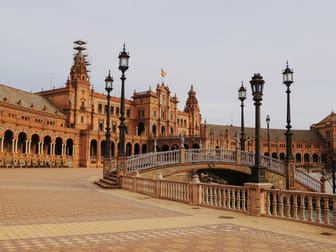Jardines del Prado de San Sebastián





Ask ThatchGPT
Suggest a local expert to plan my trip
Suggest an unique itinerary for my Spain trip
What foods do Spain locals eat
What are some true hidden gems in Spain
Help me brainstorm trip ideas for Spain
Help me plan a family-friendly trip to Spain
What people say
Pedro Pereira
Available for hire
"The former cattle fair that gave rise to the April Fair, the gardens of the Prado de San Sebastián are essential to the configuration of the city and to the understanding of its urban growth. An improvised cemetery in 1649, when the plague devastated the city, and later a fairground in 1846, the gardens as we know them today were inaugurated in 1997 after a tough struggle between the urban authorities and the real estate interests that had been bidding for decades for the construction of the place.
The gardens are structured on three levels along a longitudinal axis that starts from Avda. del Cid, establishing the whole with a marked symmetry accentuated, even more so, by a geometric design enhanced by the arrangement of the plant elements. This design also involves the use of ponds, fountains and small waterfalls, which give an unusual prominence to water in the manner in which an Islamic garden would do, leaving an open space in the central area of the gardens for social and cultural activities, such as the lively Festival of Nations that takes place there every year throughout the month of October.
Enclosed between rows of plane trees, the gardens are home to around fifty plant species. The entrance from Avda. del Cid is dominated by date palms (Phoenix canariensis) and thin-trunked Washingtonia trees (Washingtonia robusta), accompanied by lantanas or Spanish flags (Lantana camara) of great ornamental value due to their small red and yellow flowers, hence their name. If we go to the left or right, on the longitudinal side walkways, we find a large presence of tipuanas or rosewood (Tipuana tipu) that adorn the entire length of the garden with their striking yellow flowers. Also in these corridors, the thuja (Thuja orientalis) with its reddish fruits or the myrtle (Myrthus communis) with its white flowers full of stamens, which is almost always found forming hedges, attract attention.
Once we reach the corridor at the back, we find a series of roundabouts in which we find a great variety of species, among which we can mention the Indian laurel (Ficus microcarpa), the “pica pica” (Lagunaria patersonii), the jacaranda (Jacaranda mimosaefolia), or the forsythia. Returning again towards the side corridor, we find, towards the centre of the gardens, the lemon verbena (Aloysia tripylla) with its white or violet-white flowers, the tamarisk (Tamarix gallica) with pink flowers and a feathery appearance or the bamboo (Phyllostachys aurea). In the central plaza we find two groups arranged symmetrically and in steps from the Washingtonia to the Jacaranda, passing through the bitter orange tree (Citrus aurantium var. amara). Two of the corners of this plaza, the furthest from the main entrance, are decorated with yuccas (Yucca elephantipes) with white flowers and a trunk that resembles an elephant's foot."
Read more in:
Federica Vianello
"Take a stroll in these beautiful gardens. Among the flowers and benches, there are three fountains and, in winter, an ice rink.
Parks and gardens in Seville are favorite spots for tourists to sit and relax."
Read more in:
Mentioned in these guides
About Jardines del Prado de San Sebastián
Get the inside scoop on Jardines del Prado de San Sebastián from local experts, travel creators, and tastemakers. Browse genuine trip notes, Jardines del Prado de San Sebastián reviews, photos, travel guides, and itineraries from real travelers and plan your trip with confidence.
Save this spot for later or start mapping out a new trip today
Try our AI Travel Assistant and get instant answers to any questions about your trip.
Ask ThatchGPT


